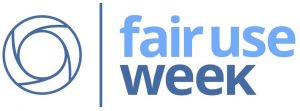This week is Fair Use/Fair Dealing Week (Feb. 20-24), a celebration of the concepts of fair use and fair dealing. The Association of Research Libraries explains that “while students, faculty, librarians and others use copyrighted material on a daily basis, Fair Use/Fair Dealing Week is a  time to promote and discuss the opportunities presented, celebrate successful stories and explain the doctrine.” You can see the full schedule of events on their website.
time to promote and discuss the opportunities presented, celebrate successful stories and explain the doctrine.” You can see the full schedule of events on their website.
Murky Waters of Fair Use
Navigating the murky waters of Fair Use for educational materials while honoring copyright law can make instructors and students at academic institutions feel like they are drowning in conflicting information. However, it is important to pay attention to when and how to use published resources so that authors and creators continue to enjoy the recognition and compensation they deserve for their intellectual property.
Fair Use principles are really more of a set of guidelines than actual rules, while U.S. copyright laws are defined in detail. Fair Use guidelines provide limited exceptions to copyright laws that allow users in non-profit, educational settings to reference copyrighted material. To make sure you are not pirating intellectual property, you need to refer to the U.S. copyright laws at www.copyright.gov. The simplest way to answer whether you may use another person’s work is to ask the copyright holder directly, or check with the U.S. Copyright Office to determine if they have more detailed information regarding the usage rights of an individual item.
Fair Use doctrine is outlined in Section 107 of the U.S. Copyright Act (Limitations on exclusive rights: Fair use). It provides four factors in determining fair use when balancing your needs with that of the copyright holder:
(1) the purpose and character of the use, including whether such use is of a commercial nature or is for nonprofit educational purposes;
(2) the nature of the copyrighted work;
(3) the amount and substantiality of the portion used in relation to the copyrighted work as a whole; and
(4) the effect of the use upon the potential market for or value of the copyrighted work.
Even an unpublished work can fall under fair use if all the above factors are considered.
“Shiver me Timbers!”
One should interpret each Fair Use Limitation as conservatively as possible to avoid copyright infringement. For example, in this blog text I have used the phrase, “Fair Use principles are really more of a set of guidelines than actual rules.” I have also used several nautical analogies that will lead many readers to recall Captain Barbossa’s quote from the movie Pirates of the Caribbean, “The code is more what you’d call guidelines than actual rules.” If we review the Fair Use guidelines we can see that this blog’s pirate homage is not in danger of violating copyright law because:
1. The reference is being used in a nonprofit educational setting.
2. The movie itself and this quote are well-known as intellectual property of the Disney Corporation.
3. The movie was not quoted directly. Rather, a phrase was used as an homage to and a variation on the movie quote.
4. The movie will retain its value, and no money will be made from the use of the phrase, therefore the Disney Corporation will not lose any money on account of the homage phrase being used.

The American Library Association confirms that Fair Use does not mean one has the right to use all copyrighted material under the designation of “educational purposes.” In fact, there are often disagreements about what constitutes fair use of a work which require a court decision:
“Section 107 is not meant to be specific. Rather, Congress intended for fair use to be determined on a case-by-case basis. … Educational and research activities are mentioned in particular as potential fair use scenarios, since these endeavors by their very nature build on the creation of new knowledge and creative work.
However, it should not be assumed that every use of a copyrighted work in an educational environment is a fair use. If a copyright holder claims that their copyright has been infringed, the defendant may argue a fair use defense. Ultimately, it is up to the court to make the final determination if a use is fair.”
It is important to remember that the copyright for a work may supersede simple citation in your own work. In other words, you may not have the right to use certain materials even if you include a citation for them. For example, the Disney company’s name and logo is a copyrighted image that may only be used by the Disney corporation for its own publications and performances. If a high school choir department does a concert of Disney songs, they must buy a copy of each song for each student singing the concert to comply with music copyright laws. In addition, the choir program may not advertise the concert as a “Disney” concert, even though they are an educational institution and they will make no money from the performance. They would instead need to advertise their concert as “Musical Movie Magic,” or something equally devoid of the company’s name, character names, or movie titles.
Now that you have a better understanding of what qualifies as Fair Use under U.S. Copyright Law, you can enjoy smooth sailing through the ocean of online and physical information resources. Bon voyage!
Catholic University Libraries
Feel free to check out our Copyright and Beyond Research Guide and specifically, our Fair Use page.
Sources
America Library Association Fair Use
https://libguides.ala.org/copyright/fairuse
Fair Use / Fair Dealing Week
https://www.fairuseweek.org/
Fair Use Fundamentals
https://www.fairuseweek.org/resources/
U.S. Copyright Law, Section 107
https://www.copyright.gov/title17/92chap1.html#107
Verbinski, G. (2003). Pirates of the Caribbean: The Curse of the Black Pearl. Buena Vista Pictures.

One thought on “Celebrate Fair Use Week!”